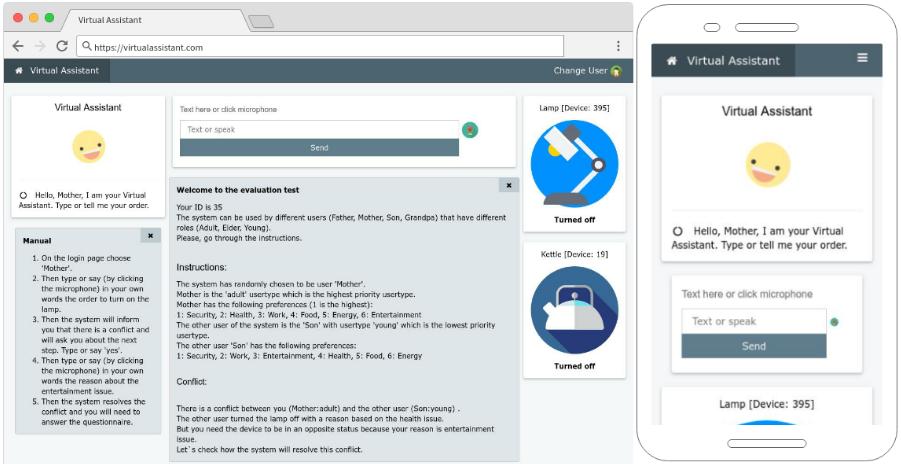-
Notifications
You must be signed in to change notification settings - Fork 2
Home
Hello...

There are wiki pages about this project, you can find all information there.
- Home page
- Terminology used
- Project structure: folders and files (What they do)
- Architecture of the system
- Main function that controls all systems
- Classification Component
- Rule-Based Reasoner Module
- Case-Based Reasoner Module
- All processes inside the system
- Evaluation test and how we did it
- How to install and run this system
Virtual Assistant is the project of the Erasmus-Plus program students in the Middlesex University, London. The main idea of the system is to control Smart-Home environment with dialogue based control interface. The system is developed to assists people with different preferences in their Activities of Daily Life (ADL). The system uses Graphical User Interface with text based dialogue window; speech recognition and text to speech generating software (Google API). Virtual Assistant uses pre-defined preferences based on age of the user profile with differentiated priorities of the needs including health, food, work, entertainment, security and energy consumption of the devices. Virtual Assistant passed the validation tests done by the developers and showed acceptable results in conflict resolution. The system uses Case-Based Reasoning module to resolve conflicts, Feed-Forward Artificial Neural Networks to classify orders of the users and the reasons of the orders. Place of the research Sunny Hill House, Middlesex University, London.
 Fig.1. Virtual Assistant Demo Page
Fig.1. Virtual Assistant Demo Page
The aim of the research is to create a voice based dialogue manager for multi-users with identical priority that allows controlling actuators inside the Sunny Hill House in conflict situations. Conflict Resolution sub-system will communicate with different users to collect the data about reasoning behind the actions they want to be done by the system. For example, if two identical users want conflicted actions to be done they will communicate with system to give reasons to act in the way they want. After that, the system will make a decision based on the new information gained from users and will give recommendations till the conflict will be eliminated. An example of that situation is described in the scenario template in the end of the proposal.
- Flask web framework
- Lucid chart diagram online editor
- Pycharm IDE
- Una animated emojies
- W3School CSS templates
- Smart Home Controller VeraSecure
- Bauyrzhan Ospan http://t.me/naboox
- Mario Jose Quinde Li Say Tan
- Kenzhegali Nurgaliyev
This project is licensed under the MIT License - see the LICENSE.md file for details
- Diseases and condition list is from https://www.cdc.gov/diseasesconditions/index.html
- Perceptron made on work of http://www.tarnlab.com/text-classification-using-neural-networks/
- Improved Multi-user Interaction in a Smart Environment Through a Preference-Based Conflict Resolution Virtual Assistant
- A Sensitivity Analysis of (and Practitioners' Guide to) Convolutional Neural Networks for Sentence Classification
- Using argumentation to manage users’ preferences
- Is Context-aware Reasoning = Case-based Reasoning?
- A survey on managing users’ preferences in ambient intelligence
- Learning frequent behaviours of the users in Intelligent Environments
- Distance Metric Learning for Large Margin Nearest Neighbor Classification
- Convolutional Neural Networks for Sentence Classification
- An Agent-Based Architecture for Sensor Data Collection and Reasoning in Smart Home Environments for Independent Living
- Design and evaluation of a smart home voice interface for the elderly: acceptability and objection aspects
- Configuration of smart environments made simple: Combining visual modeling with semantic metadata and reasoning
- Towards adaptive control in smart homes: Overall system design and initial evaluation of activity recognition
- Machine Learning Based Adaptive Context-Aware System for Smart Home Environment
- An Ontology-based Context-aware System for Smart Homes: E-care@home
- Policy Conflict Resolution in IoT via Planning
- Context-based conflict management in pervasive platforms
- SVM-Based Multimodal Classification of Activities of Daily Living in Health Smart Homes: Sensors, Algorithms, and First Experimental Results
- Context-Aware User Modeling and Semantic Interoperability in Smart Home Environments
- Text Categorization by Backpropagation Network
- Simulation of a Simple Bio-Mimetic Robot with Neuromorphic Control System and Optimization Based on the Genetic Algorithm